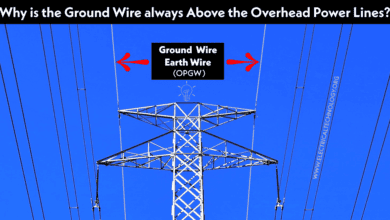How Many Utility Poles and Transmission Towers are Located Within a 1-kilometer Distance?
The number of electricity poles for distribution and towers for power transmission in a 1-kilometer distance can vary widely depending on various factors, including the level of voltage, type of power lines, supporting structure, location, local regulations, and the specific requirements of the electrical power transmission and distribution system.
In urban areas, utility poles for electricity distribution are typically placed closer together, whereas in rural areas, they may be spaced farther apart. Additionally, the number of towers and poles decreases when taller structures are used for higher voltage transmission and distribution.
The number of power transmission towers is lower than the number of distribution poles within a 1-km distance due to the tall structures supporting long spans.
Number of Distribution Poles in 1-km Distance
As a rough estimate, there are approximately 11 utility poles per kilometer in older installations, where the poles are spaced approximately 90 meters (about 300 feet) apart, and the distribution voltage is 11kV to 14kV (on Wooden, PSC for LT).
1000 meters ÷ 90 meters ≈ 11 Poles
In the newer installation, the distribution voltage has been upgraded to approximately 25kV, and taller ((iron , steel and rail) poles are used, with the poles situated ≈120 meters (≈ 400 feet) apart. As a result, the number of installed power poles per kilometer has decreased to 8.
1000 meters ÷ 120 meters ≈ 8 Poles
Number of Transmission Towers in 1-km Span
As a rule of thumb, there are 3.3 – 3.6 towers per kilometer where the distance between two structures are 275 meter to 305 meter (≈ 900 to 1000 ft) having the level of transmission voltage is 110kV to 115kV.
1000 meter ÷ 275 meters ≈ 3.6 Towers
Please note that these are approximate values, and the actual number and spacing between the poles and towers can vary based on specific circumstances, regulations, local conditions, requirements, and other factors affecting the electrical infrastructure in that area.
For example, in rural areas, the distance between utility poles (11kV to 14kV – Low Tension) may be greater than 30 meters (≈100 feet) e.g. (30-45 meters ≈ 100 – 150 ft), resulting in fewer poles per kilometer. In urban areas, the distance between poles may be less than 30 meters (≈ 100 ft), resulting in more poles per kilometer. Additionally, high voltage transmission lines typically have fewer poles per kilometer than utility poles used for distribution power lines. For example, the distance between two 13 meter tall rail poles having 33kV (High Tension) is approximately 80-100 meters (≈ 260-330 ft) while the span between two HT lattice steel towers for 66kV is ≈ 200 meters (656 ft).
Span and Distance Between Transmission Towers and Electric Poles
As already mentioned, the distance between HT power transmission towers and LT distribution poles depends on the capacity of power lines, types of towers and their structure, geographical area, and local area codes, etc. Here are the roughly estimated values for the span and distance between LT poles and HT towers.
Distance between 11kV-14kV Utility Poles
- 30 – 45 meters (≈ 100 – 150 ft)
Distance between 33kV Towers
- 80-100 meters (≈ 260 – 330 ft)
Distance between 66kV Towers
- 200 meters (≈ 656 ft)
Distance between 132kV Towers
- 250 – 300 Meters (≈ 820 – 985 ft)
Distance between 220kV Towers
- 350 Meters (≈ 1150 ft)
Distance between 400kV Towers
- 425 – 475 Meters (≈ 1400 – 1550 ft)
Based on these estimated values, you can easily determine the number of towers and poles per kilometer (0.62 miles) for utility poles and overhead transmission lines.
Related Posts:
- What is the Minimum Ground Clearance for Overhead Power Line?
- Why is the Ground Wire Always Positioned Above the Overhead Power Lines?
- What is the Purpose of Ground Wire in Overhead Transmission Lines?
- Why is the Grounding Wire Bare and Not Insulated?
- Why are Overhead Power Transmission Lines Not Insulated?
- Why are Overhead Power Lines Loose on Electric Poles & Towers?
- Difference Between Grounding, Earthing and Bonding
- Difference Between Real Ground and Virtual Ground
- What is the Difference Between Neutral, Ground and Earth?
- Why are Salt and Charcoal Added in Earthing Pit for Grounding?
- Why are Stones Used in an Electrical Substation?
- What are the Effects of Temperature on Sag in Overhead Lines?
- Why are “High Voltage” Signs used when Only Current Kills?
- Comparison Between Overhead & Underground Transmission Systems

 What is the Power Angle in a Power Transmission Line?
What is the Power Angle in a Power Transmission Line? What is Sag in Overhead Power Transmission Lines?
What is Sag in Overhead Power Transmission Lines? Why is the Ground Wire Always Positioned Above the Overhead Power Lines?
Why is the Ground Wire Always Positioned Above the Overhead Power Lines? What is the Minimum Ground Clearance for Overhead Power Line?
What is the Minimum Ground Clearance for Overhead Power Line? Why are Overhead Power Transmission Lines Not Insulated?
Why are Overhead Power Transmission Lines Not Insulated? Why are “High Voltage” Signs used when Only Current Kills?
Why are “High Voltage” Signs used when Only Current Kills?